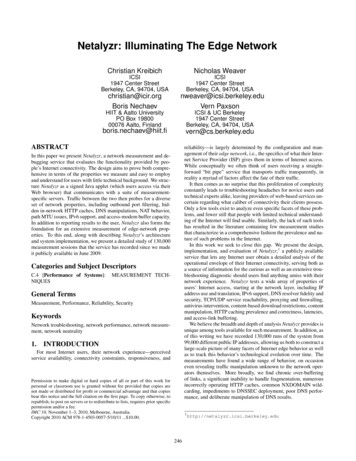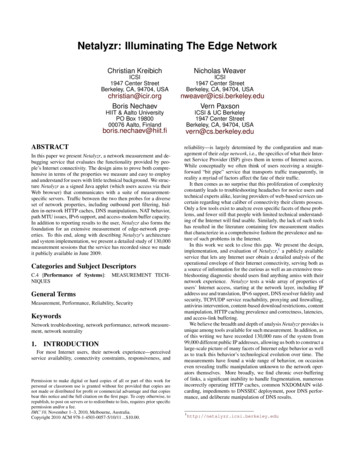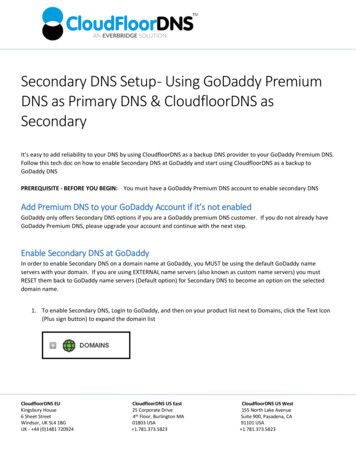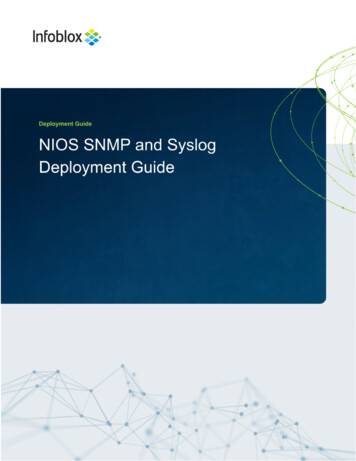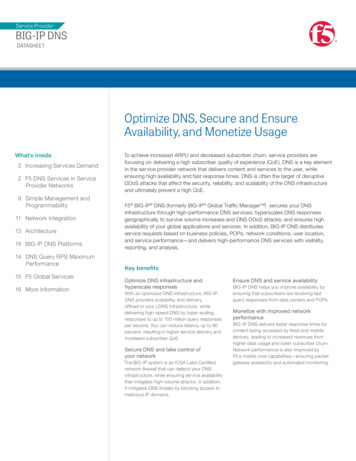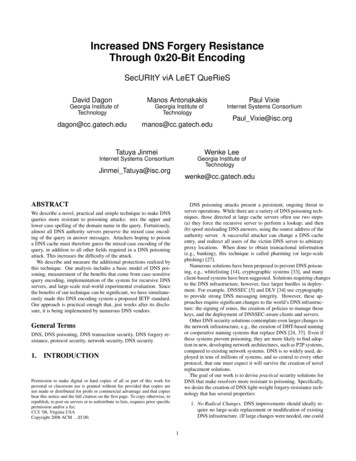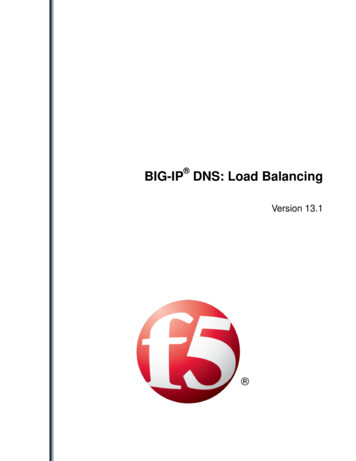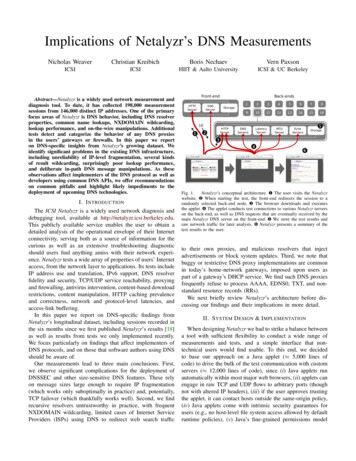
Transcription
Implications of Netalyzr’s DNS MeasurementsNicholas WeaverChristian KreibichBoris NechaevVern PaxsonICSIICSIHIIT & Aalto UniversityICSI & UC BerkeleyAbstract—Netalyzr is a widely used network measurement anddiagnosis tool. To date, it has collected 198,000 measurementsessions from 146,000 distinct IP addresses. One of the primaryfocus areas of Netalyzr is DNS behavior, including DNS resolverproperties, common name lookups, NXDOMAIN wildcarding,lookup performance, and on-the-wire manipulations. Additionaltests detect and categorize the behavior of any DNS proxiesin the users’ gateways or firewalls. In this paper we reporton DNS-specific insights from Netalyzr’s growing dataset. Weidentify significant problems in the existing DNS infrastructure,including unreliability of IP-level fragmentation, several kindsof result wildcarding, surprisingly poor lookup performance,and deliberate in-path DNS message manipulations. As theseobservations affect implementers of the DNS protocol as well asdevelopers using common DNS APIs, we offer recommendationson common pitfalls and highlight likely impediments to thedeployment of upcoming DNS technologies.I. I NTRODUCTIONThe ICSI Netalyzr is a widely used network diagnosis anddebugging tool, available at http://netalyzr.icsi.berkeley.edu.This publicly available service enables the user to obtain adetailed analysis of the operational envelope of their Internetconnectivity, serving both as a source of information for thecurious as well as an extensive troubleshooting diagnosticshould users find anything amiss with their network experience. Netalyzr tests a wide array of properties of users’ Internetaccess, from the network layer to applications. Its tests includeIP address use and translation, IPv6 support, DNS resolverfidelity and security, TCP/UDP service reachability, proxyingand firewalling, antivirus intervention, content-based downloadrestrictions, content manipulation, HTTP caching prevalenceand correctness, network and protocol-level latencies, andaccess-link buffering.In this paper we report on DNS-specific findings fromNetalyzr’s longitudinal dataset, including sessions recorded inthe six months since we first published Netalyzr’s results [18]as well as results from tests we only implemented recently.We focus particularly on findings that affect implementers ofDNS protocols, and on those that software authors using DNSshould be aware of.Our measurements lead to three main conclusions. First,we observe significant complications for the deployment ofDNSSEC and other size-sensitive DNS features. These relyon message sizes large enough to require IP fragmentation(which works only suboptimally in practice) and, potentially,TCP failover (which thankfully works well). Second, we findrecursive resolvers untrustworthy in practice, with frequentNXDOMAIN wildcarding, limited cases of Internet ServiceProviders (ISPs) using DNS to redirect web search rDNSServersMTUServer5EchoServersStorage346Fig. 1.Netalyzr’s conceptual architecture. ¶ The user visits the Netalyzrwebsite. · When starting the test, the front-end redirects the session to arandomly selected back-end node. The browser downloads and executesthe applet. ¹ The applet conducts test connections to various Netalyzr serverson the back-end, as well as DNS requests that are eventually received by themain Netalyzr DNS server on the front-end. º We store the test results andraw network traffic for later analysis. » Netalyzr presents a summary of thetest results to the user.to their own proxies, and malicious resolvers that injectadvertisements or block system updates. Third, we note thatbuggy or restrictive DNS proxy implementations are commonin today’s home-network gateways, imposed upon users aspart of a gateway’s DHCP service. We find such DNS proxiesfrequently refuse to process AAAA, EDNS0, TXT, and nonstandard resource records (RRs).We next briefly review Netalyzr’s architecture before discussing our findings and their implications in more detail.II. S YSTEM D ESIGN & I MPLEMENTATIONWhen designing Netalyzr we had to strike a balance betweena tool with sufficient flexibility to conduct a wide range ofmeasurements and tests, and a simple interface that nontechnical users would find usable. To this end, we decidedto base our approach on a Java applet ( 5,000 lines ofcode) to drive the bulk of the test communication with customservers ( 12,000 lines of code), since (i) Java applets runautomatically within most major web browsers, (ii) applets canengage in raw TCP and UDP flows to arbitrary ports (thoughnot with altered IP headers), (iii) if the user approves trustingthe applet, it can contact hosts outside the same-origin policy,(iv) Java applets come with intrinsic security guarantees forusers (e.g., no host-level file system access allowed by defaultruntime policies), (v) Java’s fine-grained permissions model
allows us to adapt gracefully if a user declines to fully trustour applet, and (vi) no alternative technology matches this levelof functionality, security, and convenience.Figure 1 shows the Netalyzr architecture. For more details,we refer the reader to our prior work [18], and here onlyreiterate the setup’s conceptual separation into front- and backends. For our DNS-related tests, we operate DNS serversrunning identical code ( 2,800 lines) on both. We developed acustom implementation because our server deliberately straysfrom the DNS standards, including replying to corruptedrequests, manipulating glue, and keeping state across queries.This implementation also facilitates extensive logging. TheJava applet uses a combination of the runtime’s DNS APIand direct UDP requests for which we craft the DNS PDUsourselves, particularly for our recent DNS test additions.The applet can run either in trusted or untrusted mode.Depending on the browser, the Java applet runtime presentsa message to the user at applet startup that asks whether theuser trusts the applet, showing the applet’s signature as anindication as to the origin of the code. If the user confirmstrust, the applet is allowed to conduct a more extensive set oftests. Details depend on the runtime’s configuration. However,we can identify the extent to which we are allowed to engagein network I/O by catching Java’s security exceptions.The DNS tests are generally driven by client-side requests;these come in the form of queries containing test directivesas part of the name that the applet looks up, such astestname.nonce.netalyzr.icsi.berkeley.edu.When mentioning test names, we will generally only showthe relevant part of the queried name. For tests with Booleanoutcomes, we return the IP address of the applet’s originserver to encode “true,” and another address for “false.” Forexample, a name starting with has edns triggers a scan ofthe request message for EDNS support, returning “true” or“false” as appropriate. Note that this Boolean approach workswithin the confines of Java’s default same-origin policy, sowe can employ it even when the applet runs untrusted. In thismode, Java only allows the applet to contact the IP addressof the server that provided the applet, but the applet can stillattempt to look up arbitrary names. The runtime enforcesrestrictions on the DNS responses: if the response containsthe IP address of the applet’s origin server, the response isdelivered; otherwise, Java generates a security exception.On the client, receipt of the origin server’s IP address thussignals “true,” while a security exception indicates “false.” Intrusted mode, we can also perform tests that encode numericvalues in the returned A records.We note that our measurements have some skew regardingwho decided to run Netalyzr, with a bias towards moretechnologically-aware users. In particular, we observe a largenumber of OpenDNS and Comcast users, mainly becausea major technology news site featured Netalyzr in contextof coverage of Comcast’s DNS policy. Our data collectionis generally prone to such “flash crowds,” resulting fromexposure the tool receives on technical blogs and news sites.Another skew comes from Netalyzr’s adoption as a debuggingtool by the on-line game League of Legends, which hasresulted in 14,700 sesions to date.III. I N -G ATEWAY DNS P ROXIESThe user’s NAT or gateway device plays a key role withrespect to the correct functioning of the DNS path. Homegateways often provide DHCP leases that configure the gateway’s own IP address as the LAN’s DNS recursive resolver.Doing so allows the gateway to support a functioning LANindependently of the global DHCP lease (which also includesDNS configuration) that the gateway acquires from the ISP. Italso enables the user to access the gateway’s administrative interface via custom DNS (such as www.routerlogin.netfor Netgear devices, or gateway.2wire.net for 2Wiresystems).DNS proxy detection. Netalyzr does not try to determinethe gateway’s IP address via intrusive scanning, so we cannotdefinitively check whether a system is configured to use a DNSproxy. However, we can detect the existence of a potentialDNS proxy by sending requests to common gateway addressesdirectly and seeing whether they elicit a response. If Netalyzrdetects that the client is behind a NAT, it probes a set oftypical gateway IP addresses. Initially, we only tried the .1address within the local subnet (e.g., given local IP address192.168.1.24, Netalyzr probed 192.168.1.1). Morerecently, it came to our attention that 2Wire and some otherdevices instead use .254, which we then added to the test.The 73% of sessions behind a NAT in which we identify an ingateway DNS proxy thus reflect a lower bound. Since 88% ofsessions are behind NATs, the behavior of these DNS proxiesis crucial, as these are the DNS “resolvers” seen by a largefraction of Internet users.1Proxy behavior. We recently broadened our DNS teststo determine how these gateways behave, including whetherthey can correctly process: (i) AAAA lookups (96% of sessions),2 (ii) TXT records (92% of sessions), (iii) unknown RRs(RTYPE 1169) per RFC 3597 [13] (91% of sessions), and (iv)EDNS0 requests (91%).External DNS functionality. To our surprise, a significantnumber of NATs have externally usable DNS proxies, as evidenced by 5.3% of the clients’ global IP addresses. Not only dothese proxies provide access to the ISP’s DNS resolution pathto unintended third parties, these proxies can be used to launchreflector attacks [22], where the attacker uses small spoofedquery to generate large responses launched at the target. Asa 100B DNS request can elicit a 4000B (enabled by EDNS0)reply, attackers can obtain 40-fold message size amplificationfor spoofed-source reflectors. Even without DNS, DNS repliesof 512B can provide 5-fold amplification. Arbor Networks1 Unfortunately, we did not check whether the end user’s system is configured to use the gateway’s proxy, or if the gateway’s DHCP server will insteadreturn the IP address of the recursive DNS resolver it receives from its ownDHCP lease [11].2 Silent failures in this manner can prove problematic for some Linuxsystems that perform A and AAAA lookups in parallel, and requirethat both lookups complete or time out before returning a record fromgethostbyname(), even when the system lacks routable IPv6 connectivity.
reports that many of the largest DDoS attacks include DNSreflectors [3].Other aberrations. We have also noticed specific aberrations with subtle effects. When debugging one of ourhome networks, we observed that a 2Wire gateway wouldprepend gateway.2wire.net to the DNS search path,but responded to *.gateway.2wire.net with SERVFAILrather than NXDOMAIN errors. Our browser repeatedly retried these lookups before moving on to the next element of thesearch path, which stalled web searches conducted by typinga word into the location bar by up to 30 sec.Finally, we have seen a small number of cases where NATs(likely D-Link products [4]) confuse AAAA and A records.When the user’s system queries for both A and AAAA recordsfor a name and the AAAA record exists but the A record doesnot (e.g., because the name reflects an IPv6-only site), the Arecord request instead returns the first 4 bytes of the AAAArecord. This behavior can also manifest if the reply for the Arecord request is simply unduly delayed.IV. F RAGMENTATION , PATH MTU, AND F ILTERINGDNS primarily relies on UDP for transmission. With theEDNS0 [24] extension mechanism for DNS, replies mayexceed the common 1500B Ethernet MTU, requiring theunderlying IP fragmentation mechanism to work correctlyin order for DNS PDUs to survive the transfer. Therefore,Netalyzr tests the client’s MTU on the path to our server. TheMTU test consists of two parts: fragmentation and path MTUdiscovery.Fragmentation. We test fragmentation by attempting tosend 2000B UDP datagrams from the client (for the client server path) and the server (server client path). Suchdatagrams are naturally fragmented, as their size exceedsthe 1500B Ethernet MTU. If the reassembled original datagram does not arrive as expected, the system cannot handlefragmented IP traffic correctly. Unfortunately this is quitecommon: 8% of the sessions cannot send fragmented UDP,and, more importantly for DNS, 9% cannot receive fragmentedUDP.Fortunately, TCP remains an option for most of theseclients. While 5% of the systems cannot contact a DNS serverover TCP, only 0.16% of the sessions both fail to receive IPfragments and lack the ability to contact DNS servers usingTCP. DNS’s TCP failover, coupled with strategies for detectingand mitigating fragmentation failures, should therefore workfairly well in practice.Path MTU. As expected, the path MTUs are commonly, butnot exclusively, that of Ethernet. We discover the precise pathMTU only in the server client direction, as the required IP“Don’t Fragment” (DF) bit is not accessible via the Java API.78% of our sessions report the full Ethernet MTU of 1500B,while 16% show the PPP-over-Ethernet [20] MTU of 1492B.Only 2% indicate an MTU of less than 1450B.Sessions with an MTU less than Ethernet’s do not reliablytrigger ICMP Destination Unreachable messages with code“Too Big:” only 60% of such sessions included these. Systemsthat employ path MTU discovery via UDP by default (suchas recent Linux versions) can in such situations frustrate thedeveloper, as the combination of unintended IP DF bits andthe failure of the ICMP mechanism conspire to create MTU“black holes” or spurious application-level exceptions.3Filtering. We have also encountered numerous firewallsand gateways that filter, block, or modify DNS over UDP.We detect these by performing both correctly and incorrectlyformatted DNS queries to our server. Content-aware devicesmay block incorrectly formatted queries, while leaving properqueries unaffected.99% of clients were able to access our DNS server overUDP with legitimate queries. Sometimes this ability is controlled by the gateway: 1.4% of sessions showed evidence ofDNS traffic being proxied or modified by the network. Thusthe request never actually was sent out over the network tothe intended recipient server, but was instead redirected to arecursive resolver which processed the request.10% of clients could access our DNS server directly withcorrect requests but not when using ill-formed requests, suggesting that a firewall or gateway enforced DNS semantics onrequests. This includes cases where a mandatory DNS proxyblocked the invalid request, as well as those behind firewallswhich only block ill-formed requests.For the results reported in [18], Netalyzr included tests todetect whether direct EDNS requests to our server are allowed.We subsequently added tests to check for filtering of AAAArecords, TXT records, and requests for unknown RRs. 98.3%of sessions succeeded at fetching AAAA records, 98.3% forTXT records, 98.5% for retrieving records using EDNS0, and95.8% for 1400B records using EDNS0. To test for retrieval ofunknown RRs, we arbitrarily used RTYPE 169, finding 97.2%of sessions could successfully retrieve these.Recent DNS proposals suggest encoding data of variousnovel types into TXT records. For example, the Sender Policy Framework [25] recommends that SPF-enabled domainsshould provide both a record of RTYPE 99 and an equivalentTXT record textually encoding equivalent information. Wefind little benefit in this redundancy, since the capability toreceive TXT records highly correlates with being able toreceive arbitrary RTYPE RRs: only 1.2% of sessions couldonly retrieve one of the two types.V. R ECURSIVE R ESOLVER P ROPERTIESNetalyzr includes extensive tests of the recursive resolver.Because of limitations the Java runtime imposes on applets, wewere unable to obtain the IP address of the recursive resolverconfigured on the client directly. We thus conduct our testsof the recursive resolver indirectly, by querying regular names3 If the ICMP “Too Big” message is not received, the application naturallyhas no immediate way of knowing that delivery failed; if it is received, relatedexceptions may be unexpected by the application developer because there wasno reason to assume sensitivity to message sizes.
using getbyname() and related API calls that return A orAAAA records.4EDNS MTUs. The path problems observed for clients alsoapply to many recursive resolvers. When we detect that theresolver uses EDNS0 (55% of sessions), Netalyzr captures theEDNS0 MTU using a name lookup that encodes the advertisedMTU in the lower 16 bits of the response A record. Netalyzrthen verifies that the resolver indeed supports this claimedMTU.We initially used three names whose lookups triggeredresponses padded to 300B, 1350B, and 1800B, respectively,using unrelated CNAME records in the Additional field. Sincethese records are almost always stripped by the recursiveresolver when returned to the client, these lookups serve totest whether the resolver indeed supports its advertised MTU.Of those sessions in which the resolver claimed the abilityto receive an 1800B response, only 87% could actually processthe large reply, while 98.5% could process the medium sizedreply. This finding suggests that a common failure modefor these queries arises from networks that cannot handlefragmentation.Accordingly, we recommend that resolvers both detect thiscondition and fail over to using a smaller (1400B) EDNS0MTU when it occurs. BIND [15] has supported a slightlydifferent failover strategy since version 9.5: when a requesttimes out, BIND will retry with an EDNS0 MTU of 512Band, if successful, use the smaller MTU for communicationwith the server. We believe that first a 1400B MTU failovershould be used and, if several servers all fail with a largerMTU but succeed with a 1400B MTU, the resolver shouldassume that the problem lies in a local firewall rather thanwith the remote servers and adjust its MTU accordingly.TCP failover. We recently added a TCP failover test toNetalyzr. The name truncate always returns a result withthe DNS truncation bit (TC) set when using UDP, but a normal(different) result via TCP. Queries for this name can determinewhether the resolver properly fails over to TCP. Only 2%of the sessions that included this test failed. 0.35% of thesessions exhibited resolvers that ignored the truncation bit,instead returning the value from the UDP datagram. 0.51%of sessions showed both an inability of the recursive resolverto handle large EDNS0 responses while advertising a largeMTU, and a failure to respond to truncation requests. Theseresults suggest that TCP failover can effectively compensatefor UDP fragmentation problems.Port randomization. We find DNS port randomizationwidespread but not universal. We released Netalyzr one yearafter cache poisoning attacks received widespread press coverage [6]. We observe that 4% of sessions still do not evinceDNS source port randomization by the recursive resolver.Most of these sessions reflect home networks running a localresolver on the NAT or end-system; in 24% of these non4 We subsequently learned that a Sun Java extension exists that can obtainthe IP address of the recursive resolver. The next release of Netalyzr will usethis information to probe the recursive resolvers directly when the extendedAPI is available.randommized sessions we find the global IP address forgeneral traffic matches the address that issues DNS requests toour server, compared to 3% of the sessions where the identifiedrecursive resolver does not match the end-system’s global IPaddress. Thus, although lack of randomization remains anissue for some users, most ISPs and institutions have fixedthis problem.Lookup latencies. We measure name lookup latency foruncached names for each Netalyzr execution, and cached-namelatency whenever the recursive resolver accepts glue records.We find the generally poor performance seen by many clientsstriking. In 10% of sessions it took 300ms longer to look up aDNS record from our server than a round-trip of a UDP packetto our back-end server. We crudely estimate that up to 100msare due to the different server locations: the front-end server,which hosts the DNS authority, is located at ICSI in Berkeley,while the back-end servers are located at Amazon’s East coastEC2 location. 4.4% of sessions required an additional 600msor more.Perhaps more surprisingly, even cached lookups are oftenslow: 11% of sessions exhibit a delay of 200ms or more forlooking up a cached record. This is strongly correlated with theusage of third-party resolvers: 15% of OpenDNS customersexperienced cached lookups taking 200ms, while 9% of nonOpenDNS users experienced an equivalent delay. 19% of thenon-OpenDNS users experience at least 100ms of delay to thecache.Figure 2 compares the latencies across different serviceproviders. For uncached latencies, distributions center justbelow 100ms with the exception of the slightly faster SBC andthe slightly slower Google. DNS providers do not appear obviously faster. A second modality is frequently present around25ms. As expected cached latencies are faster throughout, butwith differing variances.Miscellaneous tests. We employ a series of tests probingthe recursive resolver to infer its glue-handling policy. Morespecifically, we test the ability to cache glue records thatappear in either the Authoritative or Additional field. Thesetests use a different A record when included in the Additionalfield than returned by a direct lookup. We find caching ofAdditional records in 15% of sessions, but 44% of sessionscache glue included in Authoritative records.We do not observe widespread implementation of 0x20 [8](only 4.0% of sessions), but 94% of resolvers either propagatecapitalization unmodified, or directly implement 0x20. Thus,this defense holds solid promise.We find significant EDNS0 usage, with 55% of sessionsexhibiting a recursive resolver that supports it. Most of theusage occurs in the context of requesting DNSSEC data (95%of the sessions). The most common EDNS0 MTU (92% ofthe sessions) is the 4096B BIND MTU, with other MTUsincluding 512B (2.2%), 1280B (0.5%), and 2048B (1.3%).We recently added a test for whether resolvers supportAAAA-only glue records. 5.1% were able to generate requeststo IPv6-only DNS servers.
comcast.netrr.comverizon.netCachedUncachedt 0.81.00.00.20.40.60.81.0DNS Latency (s)Fig. 2. Probability densities for uncached and cached DNS lookup latencies, for the largest ISPs (top two rows) and DNS providers (bottom row). Y-axisscaling is identical across all plots.VI. L OOKUP R ESULT F IDELITYA striking finding from the Netalyzr sessions regardswidespread manipulation of results by recursive resolvers.Result wildcarding. 27% of sessions show NXDOMAINerror wildcarding, where the recursive resolver masks query errors with artificial, valid responses that usually direct browsersto a third-party site showing advertising or search engineresults potentially related to the original query. Netalyzr’sdataset has a bias towards Comcast (which now wildcards)and OpenDNS (which has always wildcarded). Even excludingthese, 24% of the sessions show wildcarding. Many of theseresolvers do not only wildcard names that begin with www,but instead act as though all name lookups returning errorsstemmed from queries generated by web browsers. ExcludingComcast (which only wildcards www) and OpenDNS (whichwildcards universally), 42% of such sessions wildcard allNXDOMAINs. Going further, 6% of sessions (1% excluding OpenDNS users) wildcard SERVFAIL in addition, anill-advised practice because it transforms the semantics oftransient error conditions.While controversial, NXDOMAIN wildcarding remains acommercial reality. Like others [7], we argue that its implementation should strive to minimize collateral damage,viewed through the lens that only web surfing provides revenueopportunity for those implementing NXDOMAIN wildcardingin its current form.We observe two other forms of wildcarding. In the first, theresolver masks a valid name’s response with a different IP protocol family. We discovered this behavior inadvertently, whileadding IPv6 functionality tests. In this form of wildcarding,a query for an IPv6-only name receives in response an IPv4address generated by the wildcarding logic. This change undermines any IPv6-only names (e.g., ipv6.google.com).Of the sessions including this test, 5% (1.0% excludingOpenDNS) will wildcard to an IPv4 address where there onlyexists an IPv6 address. In the second form, the resolver treatsresponses that confirm the server as authoritative but that omitadditional Answer RRs (e.g., because a query was performedfor an A record but the given name only has an MX orAAAA record associated with it) as NXDOMAIN errors, andwildcards them similarly. We have observed this behavior insessions using OpenDNS, and alerted them to the problem.Target-dependent redirection. Other forms of resultmanipulation exist. As we reported previously, Netalyzridentified multiple ISPs that use DNS to redirect websearches for popular sites, such as www.google.com,search.yahoo.com, and www.bing.com [18]. Insteadof visiting the intended search engines’ IP addresses, theuser winds up redirected to proxy servers. Some ISPs onlymanipulate Yahoo and Bing, while others manipulate all three.The proxy servers appear to operate as an outsourcedservice, with each ISP redirecting Yahoo and Bing to an ISP-
unique address in one of two prefixes 8.15.228/24 or69.25.212/24. The redirection occurs via the ISP’s DNSresolver, rather than via interception of DNS requests withinthe network itself, since users who use third-party resolversdo not experience redirection.Some ISPs that redirect Google use the same outsourcedproxy for it too, while others redirect Google to an ISPcontrolled proxy running apparently the same software.This software has a recognizable signature in terms of theparticular headers it when queried for hosts it does notproxy, and in particular regarding the HTML page it returns in response to ill-formed HTTP requests. A requestfor an unproxied host returns a HTTP 302 redirect tohttp://255.255.255.255/ with a banner indicatingthe Squid software version. Ill-formed requests include aHTML page with a note that the page was generated byphishing-warning-site.com, a parked domain ratherthan an actual live site.Offending ISPs include Cavalier, Charter, Cincinnati Bell,Cogent Communications, DirecPC, Frontier, Insight Broadband, Iowa Telecom, RCN, and Wide Open West. Cursoryinspection of the search result pages shows no evidence ofobvious content or header manipulation.Malware. Finally, 141 sessions showed signs of malware tampering with the resolver configuration, as observed previously by Dagon et al. [9]. These changes direct DNS requests to malicious resolvers that can thencontrol responses at will, such as by injecting advertisements [12] or deliberately disabling the resolution ofwindowsupdate.microsoft.com in order to preventsystem updates.In summary, our findings demonstrate that we cannot in general treat today’s recursive resolvers as trustworthy systems,as they are prone to manipulation. As recursive resolvers alsoplay a key role in DNSSEC validation, we argue that herethey also pose a trust problem. Ideally, end systems would onlytrust DNSSEC validations they perform themselves, bypassingthe recursive resolver to conduct queries. Clearly, such anapproach would incur significant implementation complexity,as well as diminished caching efficacy due to lack of broadersharing of cached results.VII. S UMMARY OF R ECOMMENDATIONSNetalyzr’s ongoing operations for over 1.5 years has allowedus to gather a diverse set of measurements regarding thecapabilities of today’s end systems when interacting with DNS.Based on our analysis of this data, we can make severalrecommendations to DNS implementers and users of DNSAPIs.DNS client software such as web browsers should not relyon correct reporting of NXDOMAIN or SERVFAIL errors.Non-cryptographic protocols such as HTTP can test for errorreliability by attempting a few known-to-fail and known-tosucceed queries, using the results to check for wildcarding.For cryptographic protocols, a failure to establish a connectionshould catch faulty wildcarding before the user is informedthat a problem exists, in order to prevent false alarms thatmight trip up even savvy users [10].If client software wishes to use novel RRs or TXT recordsto encode newly defined types, the client software may need toinclude its own DNS library in order to bypass the host’s stubresolver, as the latter is often configured to use the gateway’snot-fully-functional DNS proxy. The same applies to DNSSECvalidation, though here the situation is exacerbated by thefact that current stub resolvers will not necessarily performvalidations, and validations performed by the recursive resolver cannot be trusted.
website. When starting the test, the front-end redirects the session to a randomly selected back-end node. ‚ The browser downloads and executes the applet. „ The applet conducts test connections to various Netalyzr servers on the back-end, as well as DNS requests that are eventually received by the main Netalyzr DNS server on the front-end.
